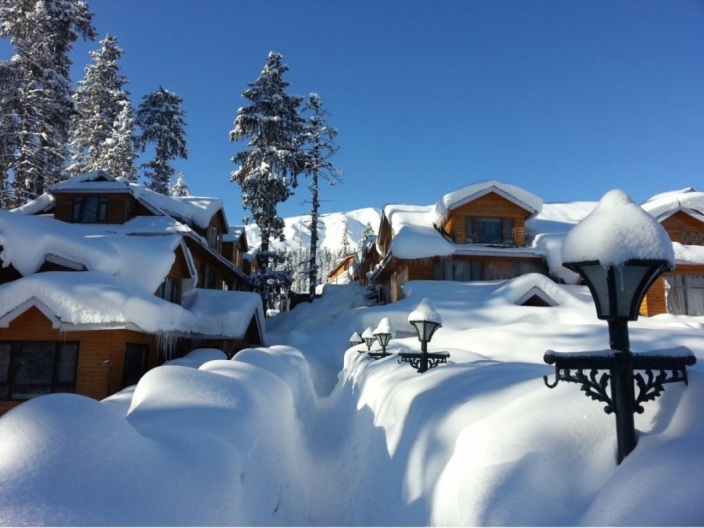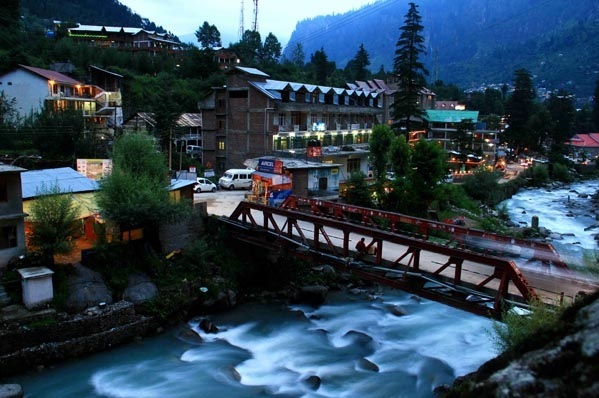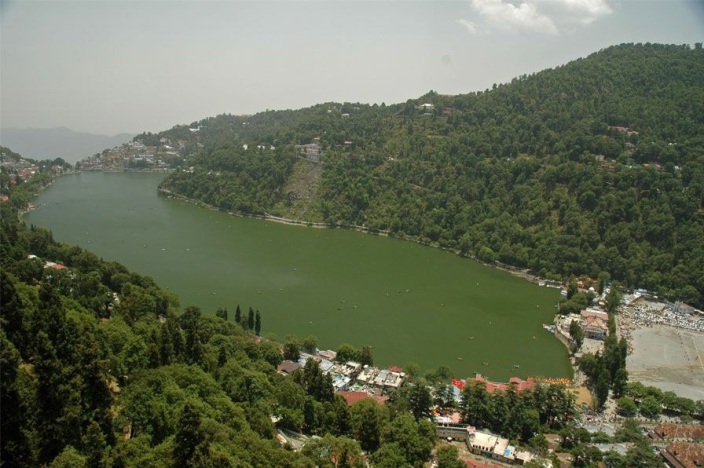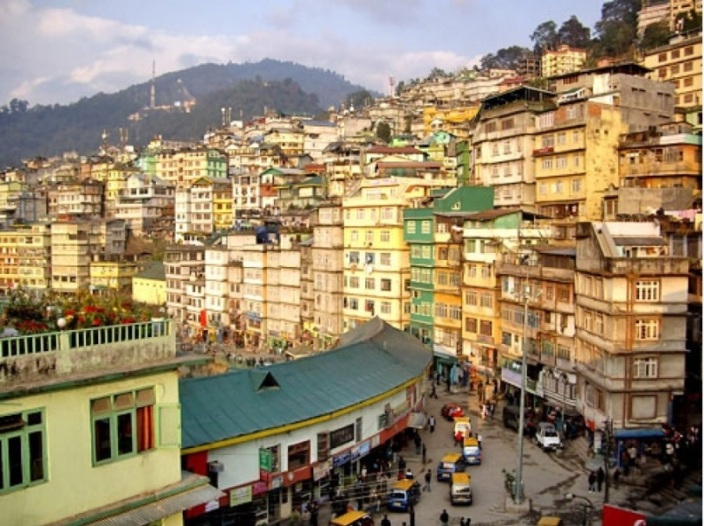DARJEELING
Over a steep mountain ridge, surrounded by tea plantations and with a backdrop of white Himalayan peaks floating over distant clouds, the archetypal hill station of Darjeeling is rightly West Bengal’s premier attraction. The towering Khangchendzonga (8598m), colonial-era architecture, Buddhist monasteries and the snow leopards and red pandas at the nearby zoo, Tiger Hill, Batasia Loop and the War Memorial is what makes Darjeeling unique. A melting pot of Himalayan races from Sikkim, Bhutan, Nepal and Tibet and beautiful local handicrafts. This is the land of the flavoured Darjeeling tea revered by connoisseurs across the globe. This is the land of the world heritage Darjeeling Himalayan Railway where the century old miniature steam engine still chugs uphill vying for space with the fast disappearing Land Rovers. It is certainly that Darjeeling in the post modern era comprises of six T’s -Tea, Teak, Tourism, Toy Train, Tiger Hill and Trekkers’ paradise.What should you bring home? Tea, tea, and more tea—and beautiful local handicrafts.
GULMARG
Originally called ‘Gaurimarg’ by shepherds, Gulmarg was discovered in the 16th century by Sultan Yusuf Shah, who was inspired by the sight of its grassy slopes emblazoned with wild flowers. It was also a favourite resort of the Mughal Emperor Jahangir. Gulmarg’s legendary beauty, prime location and proximity to Srinagar naturally make it one of Asia’s premier hill stations. Gulmarg is also a world class ski resort and has the world’s highest gondola ski lift and not to overlook, the highest green golf course in the world. It’s not so much a town as a twisting 4km-long loop of road ringing the undulating ‘Meadow of Flowers’ for which it’s named. However, the main reason to come to Gulmarg for many is to venture up through the backing stands of mature pines towards the bald ridge of Mt Afarwat. This can be done on foot or with ponies but is easiest using the two-stage gondola cable car that whisks you to 3747m for outstanding clear-day views, reputedly encompassing Nanga Parbat (the world’s ninth-highest mountain across in Pakistan) Today, Gulmarg is not merely a mountain resort of exceptional beauty but also the country’s premier ski resort in winter when it is covered in snow and takes on the appearance of a picture postcard.
MUSSOORIE
Established in the Himalayan foothills by a British Army officer in 1820, the “Queen of the Hills” stands above the rest, with its deep woods, favorable climate and Doon Valley views. It is perfect for long hikes, you will find lanes lined with pine trees and trails that lead up to gushing waterfalls inside oak-scented woods. Its name is derived from the berry-covered Mansur shrub found in abundance around this trekker-friendly area. The ghosts of its colonial past linger on in the architecture of the churches, libraries, hotels and summer palaces. The Savoy is a historic luxury hotel said to be haunted by ghosts from the past. Agatha Christie’s first novel, The Mysterious Affair at Styles, was inspired by a murder committed in the The Savoy. For stunning natural sights, head to Gun Hill or Childer’s Lodge, the two highest peaks, or the famous Kempty waterfall. Perched on a ridge 2km high. When the mist clears, views of the green Doon Valley and the distant white-capped Himalayan peaks are superb, and in the hot months the cooler temperatures and fresh mountain air make a welcome break from the plains below.
SHIMLA
The former summer capital of the British in India, and the present capital of Himachal Pradesh, Shimla has been blessed with all the natural bounties which one can think of. It has got a scenic location; it is surrounded by green hills with snow capped peaks. Bulging at its seams with unprecedented expansion, Shimla retains its colonial heritage, with grand old buildings, among them are the stately Viceregal Lodge, charming iron lamp posts and Anglo-Saxon names. The civic centre in Shimla is one of the only four heritage sites in India in the World Monument Fund endangered list. The Mall, packed with shops and eateries, is the centre of attraction of the town, and Scandal Point, associated with the former Maharaja of Patiala’s escapades, offers a view of distant snow clad peaks. Just a five hour drive from Delhi, Shimla is probably the most visited hill station in India
MANALI
An array of chic restaurant openings has turned MANALI from a backpacker jaunt into a more savvy venue for modern travelers. No wonder the towering peaks and verdant terrain of Manali attracts adventure travellers, with skiing, hiking, mountaineering and river rafting the favored active pursuits. Come down from your endorphin high by breathing deeply at the four-story, wooden Hidimba Devi Temple, which sits in the middle of a nearby deciduous forest, or take a medicinal soak in the hot springs burbling from the ground a 30-minute walk from town. With super views of the Dhauladhar and Pir Panjal Ranges, and with mountain adventures beckoning from all directions, Manali is a year-round magnet for tourists. Backpackers come to hang out in the hippy villages around the main town; adventure tourists come for trekking, paragliding, rafting and skiing; and Indian honeymoon couples or families come for the cool mountain air and their first taste of snow on a day trip to Rohtang La. As the main jumping-off point for Ladakh, Spiti and Lahaul ,it makes sense to unwind here for a few days before continuing the long journey into the mountains.
UDHAGAMANDALAM
Popularly referred to as Ooty, this gem among southern hill resorts is covered in eucalyptus and pine trees and coffee and tea plantations. Located in the Western ghats at a height of 2240m, Udhagamandalam is the headquarters of the Nilgiris district . Nilgiri is India’s first biosphere. It has been declared as one of the 14 ‘hotspots’ of the world because of its unique bio-diversity. On a clear day, it’s possible to see as far as the Mysore plateau from Dodabetta Peak, the district’s most prominent viewpoint. The Stone House, a landmark 1822 bungalow, and St. Stephen’s Church are remnants of the area’s first British settlement. Also noteworthy: formal botanical gardens, a children’s mini-garden and a contemporary art collection. Ooty combines Indian bustle and Hindu temples with lovely parks and gardens and charming Raj-era bungalows, the latter providing its most memorable (and generally most expensive) places to stay. The town was established by the British in the early 19th century as the summer headquarters of the Madras government, and memorably nicknamed ‘Snooty Ooty’. Development ploughed in a few decades ago, but somehow old Ooty survives. You just have to walk a bit further out from the centre to find it. The journey up here on the celebrated miniature train is romantic and the scenery stunning. Even the road up from the plains is pretty impressive.
MUNNAR
Munnar is situated at the confluence of three mountain streams – Mudrapuzha, Nallathanni and Kundala. 1,600 m above sea level, this hill station was once the summer resort of the erstwhile British Government in South India. Sprawling tea plantations, picture-book towns, winding lanes and holiday facilities make this a popular resort town. Munnar attract adventure travellers hungry for paragliding, treks to Anaimudi (highest peak in South India) and hikes originating at the confluence of the three mountain streams .Among the exotic flora found in the forests and grasslands here is the Neelakurinji. This flower which bathes the hills in blue once in every twelve years, will bloom next in 2018. The stone Christ Church, built by the British in 1910, is adorned with renowned works of stained glass, and Eravikulam National Park, about 10 miles away, is home to equally colourful wildlife, including the endangered Nilgiri Tahr (ibex), ruddy mongoose and 120 bird species. South India’s largest tea-growing region, the rolling hills around Munnar are carpeted in emerald-green tea plantations, contoured, clipped and sculpted like ornamental hedges. The low mountain scenery is magnificent – you’re often up above the clouds watching veils of mist clinging to the mountaintops.
NAINITAL
Crowded around a deep, green volcanic lake, Nainital is Kumaon’s largest town and favourite hill resort. It occupies a steep forested valley around the namesake lake Naini and was founded by homesick Brits reminded of the Cumbrian Lake District in Britain. Plenty of hotels are set in the forested hills around the lake, there’s a busy bazaar, and a spider’s web of walking tracks covers the forested hillsides to viewpoints overlooking the distant Himalayan peaks. For travellers, it’s an easy place to kick back and relax, eat well, go horse riding or paddling on the lake. According to mythology Naini Lake is one of the emerald eyes of Shiva’s wife. Nainital is a glittering jewel in the Himalyan necklace, blessed with scenic natural spledour and varied natural resources . Dotted with lakes , Nainital has earned the epithet of ‘ Lake District ‘ of India . Nainital is only 350km from Delhi by road and well connected to Train. Making it a popular weekend destination for people living in and around Delhi.
GANGTOK
Wreathed in clouds, Gangtok, the capital city of Sikkim is located on a ridge at a height of 5500 feet. With a spectacular view of the Khangchendzonga, the town provides the perfect base for travel through the state. Once an important transit point for traders traveling between Tibet and India, it is today a busy administrative and business centre and presents an interesting mix of cultures and communities. Irreverent, laid-back and happy-go-lucky Gangtok, is mostly a functional sprawl of urban concrete interspersed with patches of forestry. True to its name (meaning ‘hill top’), the city perches along a precipitous mountain ridge, descending down the hillside in steep tiers. It reflects a unique ambience which derives from its happy blend of tradition and modernity. Alongside the deeply felt presence of stupas and monasteries, Gangtok also bustles like any other thriving town. Some of the key places to visit include Rumtek Monastery, Do-Drul Chorten, Enchey Monastery, Tashi View Point and the Lal Bazaar. Apart from the few sights of religious importance and an inspiring view of Khangchendzonga soaring above the western horizon, there isn’t much to see in town. That said, travellers love its relaxed grain and often linger here for a few days, soaking up the local culture while arranging their travels (e.g treks and tours) around the state.
Reference: State tourism websites, tripadvisor, lonelyplanet
For your trip to any of the most loved hill stations contact Road2travel








